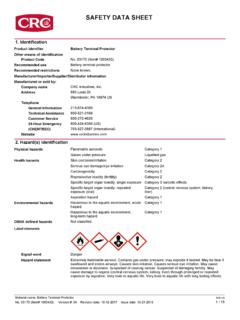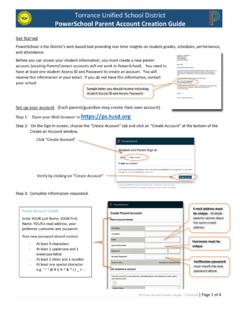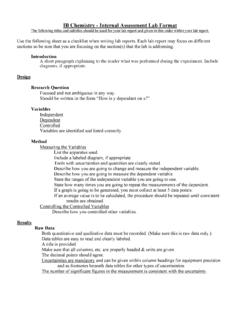Transcription of Basic Practical Microbiology
1 Basic Pract Cover 2009 16/1/09 12:01 Page 3. Basic Practical Microbiology A Manual Society for General Microbiology (SGM). Basic Pract Cover 2009 16/1/09 12:01 Page 2. The Society for General Microbiology (SGM) is a learned society with over 5,000. members worldwide who work in universities, industry and research institutes. The Society aims to encourage a greater public understanding of Microbiology and biotechnology by school pupils and the public. It produces and distributes a wide range of resources to support Microbiology teaching in schools and colleges across all key stages and post-16. The Society offers membership to schools, runs courses and offers an information service to teachers.
2 SGM has a charitable status. 2006 Society for For information, see or contact: Education General Microbiology Department, SGM, Marlborough House, Basingstoke Road, Spencers Wood, Reading RG7 1AG, UK (Tel. 0118 988 1835; Fax 0118 988 5656;. ISBN 0 95368 383 4 Email Basic Pract Book 2006 2/11/06 11:17 am Page 1. Contents About this resource Inside front cover Part 1: The Basics An introduction to Microbiology , aseptic technique and safety Preparation Safety guidelines 1. Risk assessment 2. Good microbiological laboratory practice (GMLP) 3. Spillage management 3. Aerosols 3. Resources Equipment 4. Apparatus 5. Materials 5. Media, sterilisation and disinfection Preparation of culture media 6.)
3 Pouring a plate 6. Storage of media 6. Sterilisation vs disinfection 6. Sterilisation using the autoclave/pressure cooker 7. Sterilisation of equipment and materials 7. Choice, preparation and use of disinfectants 7. Inoculation and other aseptic procedures Essential points 8. Using a wire loop 8. Using a pipette 9. Flaming the neck of bottles and test tubes 10. Working with bacteria and yeast Streak plate 11. Pour plate 12. Using a spreader 13. Spread plate 14. Working with moulds 15. Incubation 16. In conclusion: clearing up 17. Basic Pract Book 2006 2/11/06 11:17 am Page 2. Essential methods for maintaining, preparing and using cultures Obtaining suitable cultures 18. Pure cultures 18.
4 Maintaining stock cultures 18. Checking cultures for contamination 18. Preventing contamination of cultures and the environment 19. Aseptic transfer of cultures and sterile solutions 19. Preparing cultures for class use 19. Part 2: Microbiology in Action Practical activities 1. Testing sensitivity to antimicrobial substances 21. 2. Microscopy Using the microscope 22. Stained preparations 23. Making a smear 23. A simple stain 24. A differential stain: Gram's staining method 24. Appendices 1. Safety guidelines 26. 2. Safe micro-organisms 31. 3. Safety resources 37. 4. Suppliers of cultures and equipment 38. 5. Use of the autoclave/pressure cooker 39. 6. Preparing serial dilutions 40.
5 Basic Pract Book 2006 2/11/06 11:17 am Page 1. Part 1: The Basics An introduction to Microbiology , aseptic technique and safety As well as causing a familiar range of diseases in animals and plants and problems in food spoilage and deterioration of other materials, microbes are also our invisible allies'. Indeed, life on Earth would not be sustainable without the benefits that many of them provide. The teaching of such an important subject as Microbiology cannot be achieved effectively without enhancing the theory with hands on' experience in the laboratory. The purpose of this manual is to provide teachers and technicians with good techniques in Practical Microbiology to ensure that investigations proceed safely and achieve the required educational aims successfully.
6 This manual has been written for a right-handed person. Preparation Safety guidelines The small size of microbes and the consequent need to deal with cultures that contain many millions of microbial cells require special procedures for their safe use. Activities involving micro-organisms are controlled by the Control of Substances Hazardous to Health (COSHH) Regulations and teachers and technicians have a duty under the Health and Safety at Work Act to comply with any safety instructions given by their employers. These include using model risk assessments for which it is necessary to refer to appropriate publications such as CLEAPSS Laboratory Handbook (2006), section , Topics in Safety, 3rd edition (ASE, 2001), Microbiology : an HMI Guide (DES, 1990) and Safety in Science Education (DfEE, 1996).
7 The guidelines are straightforward and largely common sense and, as such, are not an obstacle to conducting interesting microbiological investigations in a school laboratory. Planning ahead is essential when embarking on Practical Microbiology investigations. There are five areas for consideration. Preparation and sterilisation of equipment and culture media. Preparation of microbial cultures as stock culture for future investigations and inoculum for the current investigation. Inoculation of the media with the prepared culture. Incubation of cultures and sampling during growth. Sterilisation and safe disposal of all cultures and decontamination of all contaminated equipment.
8 [Appendix 1: Safety guidelines] [Appendix 3: Safety resources]. Basic Practical Microbiology A Manual 2006 SGM 1. Basic Pract Book 2006 2/11/06 11:17 am Page 2. Risk assessment A full risk assessment must be carried out before embarking on any Practical microbiological investigation. For model risk assessments, adaptations to model risk assessments and factors which need to be considered when contemplating carrying out Practical work that is not covered by a model risk assessment, see CLEAPSS Laboratory Handbook (revised 2001), section and CLEAPSS Guide L169, Managing Risk Assessment in Science 1997. Factors to be considered in risk assessment Factor Relevance Level of Practical work Degree of risk of microbial culture; expertise of teacher; age range of [Level 1, Level 2, Level 3, Topics in Safety, students 3rd edition (ASE, 2001), Topic 15; or Appendix 1: Safety guidelines].
9 Choice of micro-organisms (ACDP Hazard Present minimum risk; refer to list of suitable cultures Group 1). Source of cultures Reputable specialist supplier or approved environmental sample Type of investigations/activities Adequate containment of cultures; class Practical work vs. teacher demonstration Composition of culture media Possibility of selecting for growth of pathogens Volume of cultures Increased risk with increase in volume of liquid culture Laboratory facilities Suitability for level of Practical microbiological work Equipment Adequate for purpose Incubation conditions Possibility of selecting for growth of pathogens Disposal procedures Ensures elimination of risk to others Expertise of technicians and teachers Competence and level of training in techniques and procedures appropriate to level of Practical work Student age and discipline Appropriate to level of Practical work.
10 Confidence in class discipline Sources of competent advice ASE*, CLEAPSS*, MISAC, NCBE, SSERC* (*members only). Useful check list CLEAPSS Laboratory Handbook (2006), section or Topics in Safety, 2nd edition (ASE, 1988), pp. 34 37. Essential reference Topics in Safety, 3rd edition (ASE, 2001), Topic 15 or CLEAPSS Laboratory Handbook (2006), section or Appendix 1: Safety guidelines Key to abbreviations: ACDP, Advisory Committee on Dangerous Pathogens; ASE, Association for Science Education;. MISAC, Microbiology in Schools Advisory Committee; NCBE, National Centre for Biotechnology Education; SSERC, Scottish Schools Equipment Research Centre. [Appendix 1: Safety guidelines]. [Appendix 2: Safe micro-organisms].




